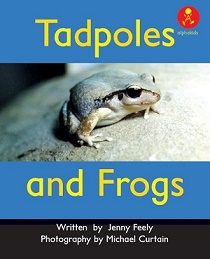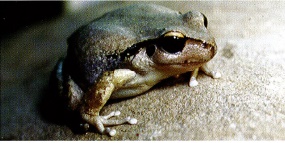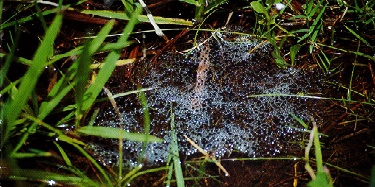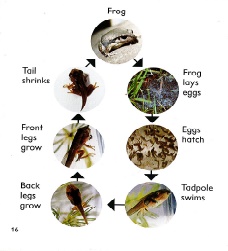This lesson will require students to read and understand a non-fiction text about the life cycle of a frog.
Text details
Tadpoles and Frogs, Author Jenny Feely
Reproduced by permission. Source: Tadpoles and Frogs, Author Jenny Feely, Program AlphaKids published by
Eleanor Curtain Publishing Pty Ltd. © EC Licensing Pty Ltd.
Text contains
The text contains opportunities to:
- read a labelled life cycle diagram
- understand that images can support the meaning and assist the reader as they decode the text
- identify a non-fiction text and some of its characteristics
- practise reading with phrasing and fluency
- learn new vocabulary associated with frogs.
The text contains:
- simple sentences e.g. “The tadpole’s back legs grow”
- common nouns, e.g. eggs, tadpole(s), water, plants, legs, tail, frog verbs, e.g. lays, hatch, swims, eats, grow, shrinks, is
- adjectives, e.g. front legs, back legs.
Using images in a factual text to support meaning
Links to the Victorian Curriculum – English
Foundation
Reading and viewing
Explore the different contribution of words and images to meaning in stories and informative texts. For more information, see:
Content description VCELA146
Recognise that texts are made up of words and groups of words that make meaning. For more information, see: Content description VCELA144
Level one
Reading and viewing
Compare different kinds of images in narrative and informative texts and discuss how they contribute to meaning. For more information, see: Content description VCELA180
Links to Victorian Curriculum - English as an Additional Language (EAL)
Pathway A
Reading and viewing
Level A1
Identify familiar words and simple sentences and match them to images
(VCEALC032)
Understand that texts are meaningful
(VCEALA035)
Level A2
Use knowledge of context, text structure and language to understand literal and inferred meanings
(VCEALC114)
Understand how different types of images in texts contribute to meaning
(VCEALA116)
Pathway B
Reading and viewing
Level BL
Acquire information from simple images, with teacher direction and support
(VCEALC186)
Level B1
Acquire some information from a small range of images
(VCEALC266)
Learning intention
We are learning that images or pictures can support the meaning of the text.
Success criteria
We can look at a photo in this text and use the meaning to help predict an unknown word in the text.
Theory/practice connections
Successful reading means drawing together several sources of information. Illustrations, photos, figures and tables all contribute to the overall meaning. Students need to know that the text and the pictures/photos often work together to make meaning (e.g. Look at the picture. How might it help you?).
Teachers need to prompt for this link particularly in the early stages of a student’s reading development. Once students know this link, they are able to internalise it and use the knowledge to read texts with more complexity (Clay, 1993; Hill, 2015).
Lesson sequence
- Clearly articulate the learning intention.
- Today we are learning how the photos in this book can help us with the meaning of the text. We know that when we read it has to make sense. Using the photos to help with the meaning will also help us predict the words that might be in the text. You will know if your learning has been successful if you can give me an example where you looked at a picture and then predicted a word which made sense on the page.
- Hand text to each student. Read title and discuss the front cover. Activate prior knowledge by asking students, “What do you know about frogs?”
- Teacher and students look through the pages. The teacher directs the discussion and asks students to turn to:
- Page 3: Look at the two photographs.


Ask students to discuss the photos (i.e. a frog and eggs on the water). - Make the link that they could expect to see the words ‘frog’ and ‘eggs’ in the adjacent text because the photos support the text. Ask students to try and locate both words in the sentence, “The frog lays eggs on the water.” Discuss how closely the nouns and the photographs match. Tell students that when they are decoding a text, the pictures and/or photographs that accompany the text are there to support meaning. Often these words name items and are called nouns.
- Repeat process with the rest of the text. Frontload unfamiliar verbs in text (lays, shrinks, hatch, grow) matching sounds to letters.
- Students read text quietly to themselves. They may need to read twice for understanding. During this time, the teacher hears each child in the group read individually. The teacher selects prompts to support the learning needs of each child (e.g. Look at the photograph, now look at the unknown word. What sound does it start with? Is there something in the photograph that starts with that sound? What could it be? Let’s read it. Does the word make sense?).
- Check for understanding. Ask students to recall the life cycle stages that a frog goes through. Encourage students to use the nouns and verbs related to frogs in their recall. Clarify the meaning of any terms that are unclear e.g. hatch, shrink.
- Return to the learning intention and success criteria. Ask students to select a photo from the text and name an item within it by suggesting a noun. Then ask them to show where the noun appears in the text. Record anecdotal responses for future planning.
Reading labelled diagrams
Links to the Victorian Curriculum – English
Foundation
Reading and viewing
Explore the different contribution of words and images to meaning in stories and informative texts. For more information, see:
Content description: VCELA146
Recognise that texts are made up of words and groups of words that make meaning. For more information, see: Content description VCELA144
Level one
Reading and viewing
Compare different kinds of images in narrative and informative texts and discuss how they contribute to meaning. For more information, see:
Content description VCELA180
Links to Victorian Curriculum – English as an Additional Language (EAL)
Pathway A
Reading and viewing
Level A1
Level A2
- Understand how different types of images in texts contribute to meaning
(VCEALA116)
- Use developing knowledge of English to predict some words or phrases
(VCEALL127)
Pathway B
Reading and viewing
Level BL
- Acquire information from simple images, with teacher direction and support
(VCEALC186)
- Make simple predictions or inferences about a text, with support
(VCEALC189)
Level B1
- Acquire some information from a small range of images
(VCEALC266)
- Make simple predictions or inferences about a text
(VCEALC269)
Learning intention
I am learning that labelled diagrams give the reader extra information about a topic.
Success criteria
I can transfer my learning about labelled diagrams by thinking of another life cycle. I can share my idea with others.
Theory/practice connections
Successful reading means drawing together several sources of information. Illustrations, photos and diagrams all contribute to the overall meaning.
Students need to know that the text and labelled diagrams work together to make meaning (e.g. Look at the diagram. What information is it giving you?).
Teachers need to prompt for this link particularly in the early stages of a student’s reading development. Once students know this link, they are able to internalise it and use the knowledge to read texts with more complexity (Clay, 1993; Hill, 2015).
Lesson sequence
- Clearly articulate the learning intention.
- Today we are learning how to read a labelled diagram. We will look at an example so we know what a diagram is. We will also look at the information it is telling us. At the end of the lesson we are going to use this example to think of another life cycle and how we might label it.
- Hand text to each student. Read title and discuss the front cover. Activate prior knowledge by asking students, “What do you know about frogs?”
- Teacher and students look through the pages. The teacher models the language of the text through the discussion:
- Page 5: Look at the picture. What can you see? They are called tadpoles. They hatch from the frog’s eggs. Point to the word that says ‘tadpoles’. How do you know? (Reinforce initial letters as a cue, breaking the word into parts: tad/poles). Repeat with the word ‘hatch’ and reinforce the /tch/ trigraph at the end of the word. Students locate and articulate.
- Page 8 and 9: What are the tadpoles going to grow next? Where are the legs? Scaffold students to use the adjectives ‘back’ and ‘front’. Identify adjectives in the text focussing on matching sounds to letters.
- Students read text quietly to themselves. They may need to read twice for understanding. During this time, the teacher hears each child in the group read individually. The teacher selects prompts to support the learning needs of each child. (e.g. Does that word look right? Can you make the first sound? Can you break the word into parts to help sound out?).
- Check for understanding. Turn to the back page (page 16).
- Ask students to point to the picture of a frog. Ask them to recall what the frog did first and what happened next. Prompt students to follow the arrows and images to guide their recall.

- Introduce the term ‘life cycle’ and discuss how the diagram is positioned on the page. Ask students why they think it is presented in a circle format. Discuss what information the life cycle diagram gives the reader and how it supports the content in the text.
- Return to the learning intention and the success criteria. Ask students to suggest another animal and discuss their life cycle in terms of stages (e.g. butterfly, eggs, caterpillar, and chrysalis). Record anecdotal responses for future planning.
Going further
As a follow up, students could draw their own labelled life cycle diagram and share with others.
ABC Education Literacy Mini Lessons
The Department collaborated with ABC Education to create a series of videos. All 16 mini lessons based on content from the Literacy Teaching Toolkit are available on the
ABC Education literacy mini lessons page.
Structures and features of a non-fiction text
Links to the curriculum
Foundation
Reading and viewing
Identify some differences between imaginative and informative texts. For more information, see:
Content description VCELY154
Understand that texts take many forms, and that imaginative and informative texts have different purposes. For more information, see:
Content description VCELA141
Level one
Reading and viewing
Describe some differences between imaginative, informative and persuasive texts, and identify the audience of imaginative, informative and persuasive texts. For more information, see:
Content description VCELY188
Understand that the purposes texts serve shape their structure in predictable ways. For more information, see:
Content description VCELA176
Links to Victorian Curriculum - English as an Additional Language (EAL)
Pathway A
Reading and viewing
Level A1
- Identify purposes for reading, such as reading for enjoyment and reading for information
(VCEALA036)
- Recognise and explore different types of texts
(VCEALL042)
- Understand and explore the basic features of different texts
(VCEALL043)
Level A2
- Understand that the purpose of a text is reflected in its form
(VCEALA117)
- Identify and compare differences in text genres
(VCEALL123)
- Understand and use the basic features of different texts
(VCEALL124)
Pathway B
Reading and viewing
Level BL
- Show awareness that texts convey meaning
(VCEALA191)
- Understand and explore the basic layout and conventions of simple texts
(VCEALL200)
Level B1
- Understand that people read texts for a variety of purposes
(VCEALA271)
- Understand the purpose and basic organisational features of simple text types
(VCEALL280)
Learning intention
We are learning how a non-fiction text is organised and how the features help us read it.
Success criteria
We are able to recall one characteristic of a non-fiction text.
Theory/practice connections
The use of non-fiction texts is a key element in a balanced reading program. If we want students to be able to read and comprehend a range of texts, we must ensure that we include examples of various genres in our explicit teaching.
Non-fiction texts must be introduced to students as they are beginning to learn to read and continue throughout their schooling; as shared texts, guided reading texts and independent texts. (Duke, Pearson, Strachan & Billman, 2011).
Lesson sequence
- Clearly articulate the learning intention. Today we are looking at a non-fiction text. We are going to talk about what makes it non-fiction and find some examples. At the end of the session, you will know if you have successfully learnt about what makes a text non-fiction by showing or saying one thing that tells you the text is non-fiction.
- Hand text to each student. Read title and discuss the front cover. Activate prior knowledge by asking students, “What do you know about frogs?”
- Teacher and students look through the pages. The teacher models the language of the text through the discussion: Page 5: Look at the picture. What can you see? They are called tadpoles. They hatch from the frog’s eggs. Point to the word that says ‘tadpoles’. How do you know? (Reinforce initial letters as a cue, breaking the word into parts: tad/poles). Repeat with the word ‘hatch’ and reinforce the /tch/ trigraph at the end of the word. Students locate and articulate. Page 8 and 9: What are the tadpoles going to grow next? Where are the legs? Scaffold students to use the adjectives ‘back’ and ‘front’. Identify adjectives in the text focussing on matching sounds to letters.
- Students read text quietly to themselves. They may need to read twice for understanding. During this time, the teacher hears each child in the group individually. The teacher selects prompts to support the learning needs of each child. (e.g. Does that word look right? Can you make the first sound? Can you break the word into parts to help sound out?).
- Check for understanding. Ask students to recall the life cycle stages that a frog goes through. Encourage students to use the nouns and verbs related to frogs in their recall. Clarify the meaning of any terms that are unclear e.g. hatch, shrink.
- Ask students to think about the information discussed. What do they notice? Non-fiction texts contain facts. Introduce term. Ask students to find an example of a fact (i.e. something that is true and not made up).
- Ask students to continue to look through the text. Discuss the other characteristics which are common to non-fiction texts (e.g. photographs, labelled diagram, general participants not specific characters).
- Return to the learning intention and the success criteria. Ask students how we know a text is non-fiction text? Ask them to recall one characteristic of a non-fiction text.
Going further
As a follow up students find other examples of non-fiction texts using the discussion to guide their choice. Share with the group.
ABC Education Literacy Mini Lessons
The Department collaborated with ABC Education to create a series of videos. All 16 mini lessons based on content from the Literacy Teaching Toolkit are available on the
ABC Education literacy mini lessons page.
Reading with phrasing and fluency
Links to the Victorian Curriculum - English
Foundation
Reading and viewing
Read texts with familiar structures and features, practicing phrasing and fluency, and monitor meaning using concepts about print, semantic, contextual and grammatical knowledge. For more information, see: Content description VCELY152
Level one
Reading and viewing
Read texts with familiar structures and features using developing phrasing, fluency, phonic, semantic, contextual, and grammatical knowledge and emerging text processing strategies, including prediction, monitoring meaning and rereading. For more information, see: Content description VCELY187
Links to Victorian Curriculum - English as an Additional Language (EAL)
Pathway A
Reading and viewing
Level A1
- Identify repetitive words or phrases in known texts
(VCEALL047)
- Recognise capital letters, spaces and full stops
(VCEALL052)
- Follow text with finger while reading
(VCEALL053)
- Adopt the teacher's intonation patterns when reading familiar texts
(VCEALL054)
Level A2
- Read familiar phrases and sentences with fluency
(VCEALL128)
- Recognise that full stops and question marks separate text
(VCEALL133)
- Sub-vocalise when reading silently
(VCEALL134)
- Read familiar texts with some fluency
(VCEALL135)
Pathway B
Reading and viewing
Level BL
- Understand the function of spaces, capital letters and full stops
(VCEALL209)
- Demonstrate reading-like behaviour
(VCEALL210)
- Attempt to self-correct
(VCEALL211)
- Revisit familiar texts to develop accurate and fluent reading
(VCEALL213)
Level B1
- Recognise the function of capital letters and full stops, and use them
(VCEALL289)
- Self-correct with guidance
(VCEALL291)
- Reread familiar texts to increase accuracy and fluency and to enhance understanding
(VCEALL293)
Learning intention
I can read with phrasing and fluency.
Success criteria
I can use the grouped words on each line of text to help me with phrasing.
Theory/practice connections
Promoting fluency is an important element which contributes to reading for meaning. Fluency and comprehension have a co-dependent relationship. When a reader reads fluently, they are doing so in phrased groupings, pausing at appropriate punctuation or using it to add expression.
When students can do this independently, there is a strong indication of reading for meaning. A student’s working memory has been freed up to concentrate on the meaning rather than the slow and halting process of decoding every word (Konza, 2010). Fluency is promoted by rereading familiar texts after the initial decoding has been done (Clay, 1993).
Lesson sequence
- Clearly articulate the learning intention. Today we are learning how to read fluently. This is an important skill because fluency helps us understand what we are reading. We are going to learn a strategy to help read fluently. By the end of the session you will be able to demonstrate how you have used this strategy to read fluently.
- Hand text to each student. Read title and discuss the front cover. Activate prior knowledge by asking students, “What do you know about frogs?”
- Teacher and students look through the pages. The teacher models the language of the text through the discussion: Page 5: Look at the picture. What can you see? They are called tadpoles. They hatch from the frog’s eggs. Point to the word that says ‘tadpoles’. How do you know? (Reinforce initial letters as a cue, breaking the word into parts: tad/poles). Repeat with the word ‘hatch’ and reinforce the /tch/ trigraph at the end of the word. Students locate and articulate. Page 8 and 9: What are the tadpoles going to grow next? Where are the legs? Scaffold students to use the adjectives ‘back’ and ‘front’. Identify adjectives in the text focussing on matching sounds to letters.
- Students read text quietly to themselves. They may need to read twice for understanding. During this time, the teacher hears each child in the group read individually. The teacher selects prompts to support the learning needs of each child. (e.g. Does that word look right? Can you make the first sound? Can you break the word into parts to help sound out?).
- Check for understanding. Ask students to recall the life cycle stages that a frog goes through. Encourage students to use the nouns and verbs related to frogs in their recall. Clarify the meaning of any terms that are unclear e.g. hatch, shrink.
- Ask students to return to page 2. Count the number of sentences on the page. Count the number of lines of text on the page. Tell students that the author has deliberately made a decision to put the sentence on two lines to help the reader read with phrasing. Phrasing helps the reader to understand the text by grouping words into meaningful chunks.
- The teacher models how to phrase the sentence “The frog lays eggs/on the water.” Ask students to practise reading page 2, using the lines as a prompt for phrasing. Repeat this process with page 6 (e.g. “The tadpole swims/and eats plants/in the water”).
- Students work with a partner. Re-read the text to their partner using the placement of text as a prompt for phrasing. The teacher listens to each pair and provides feedback/ remodels to support phrasing and fluency. Discuss their attempts in terms of the success criteria. Record anecdotal responses for future planning.
Going further
As a follow up, students practise reading with phrasing and fluency and share a section of the text with others.